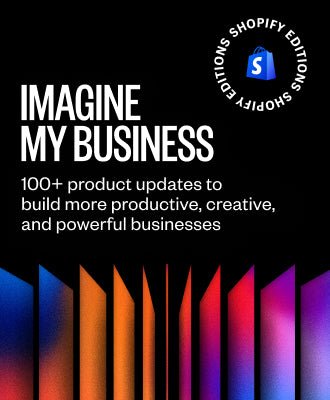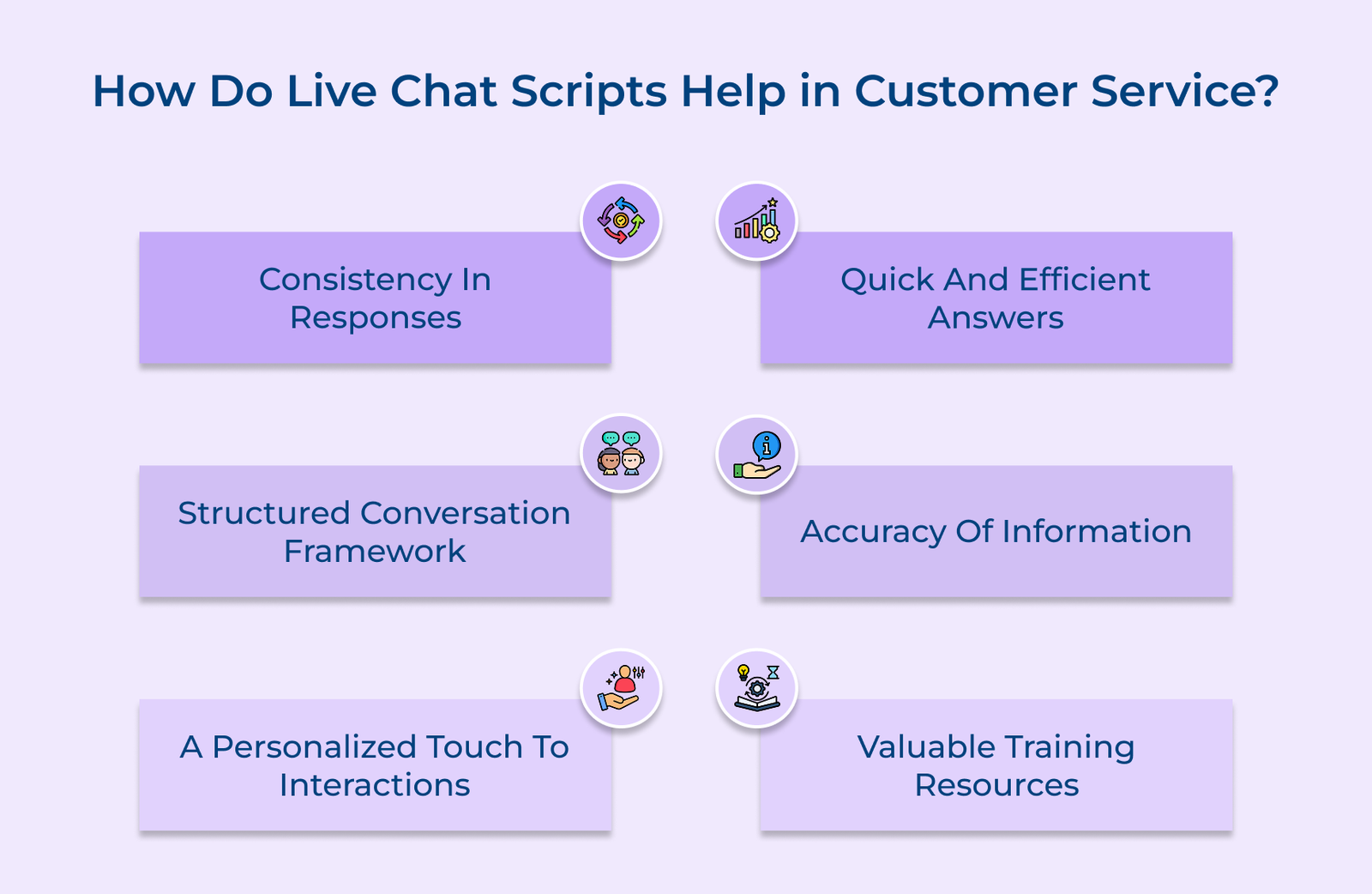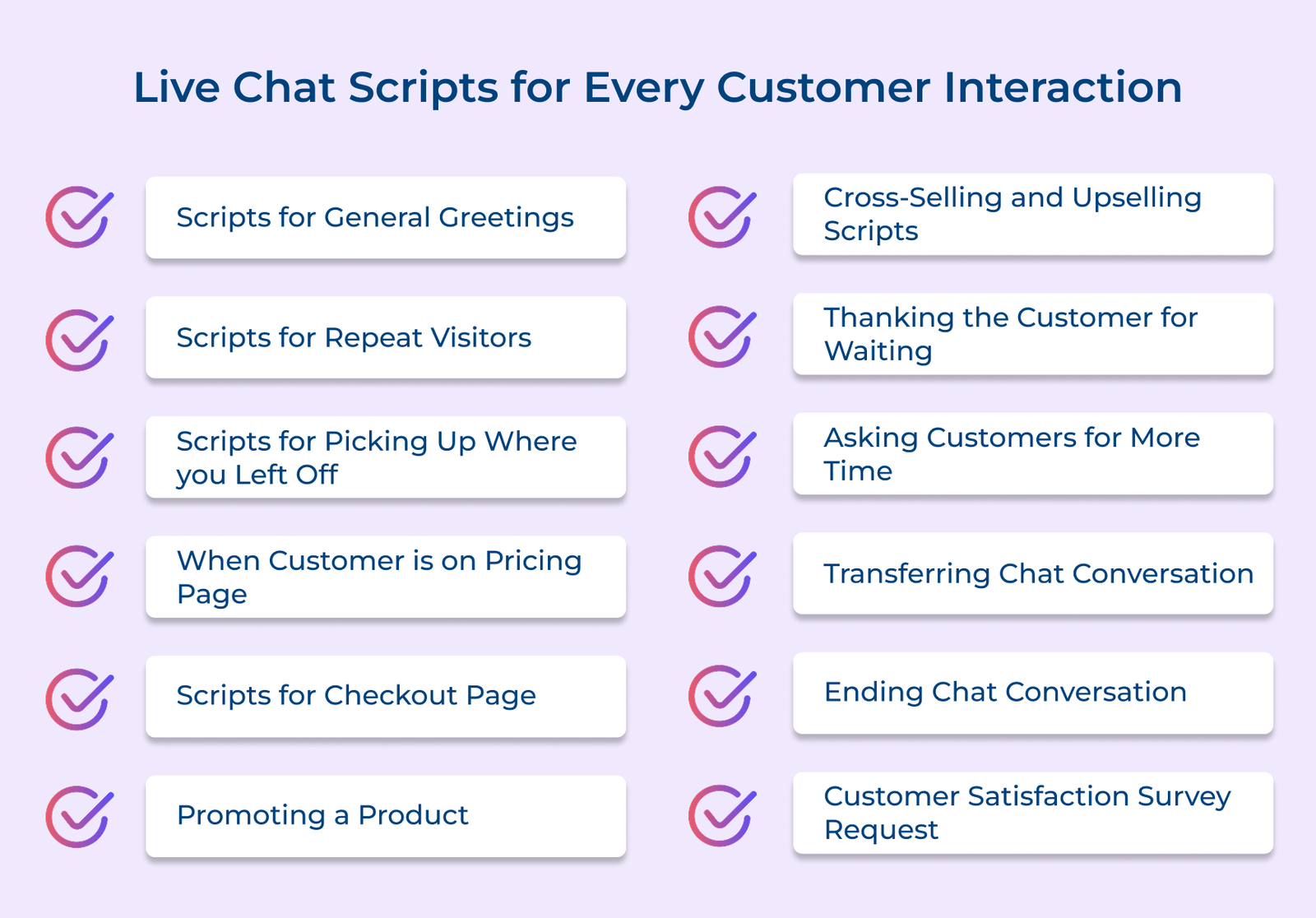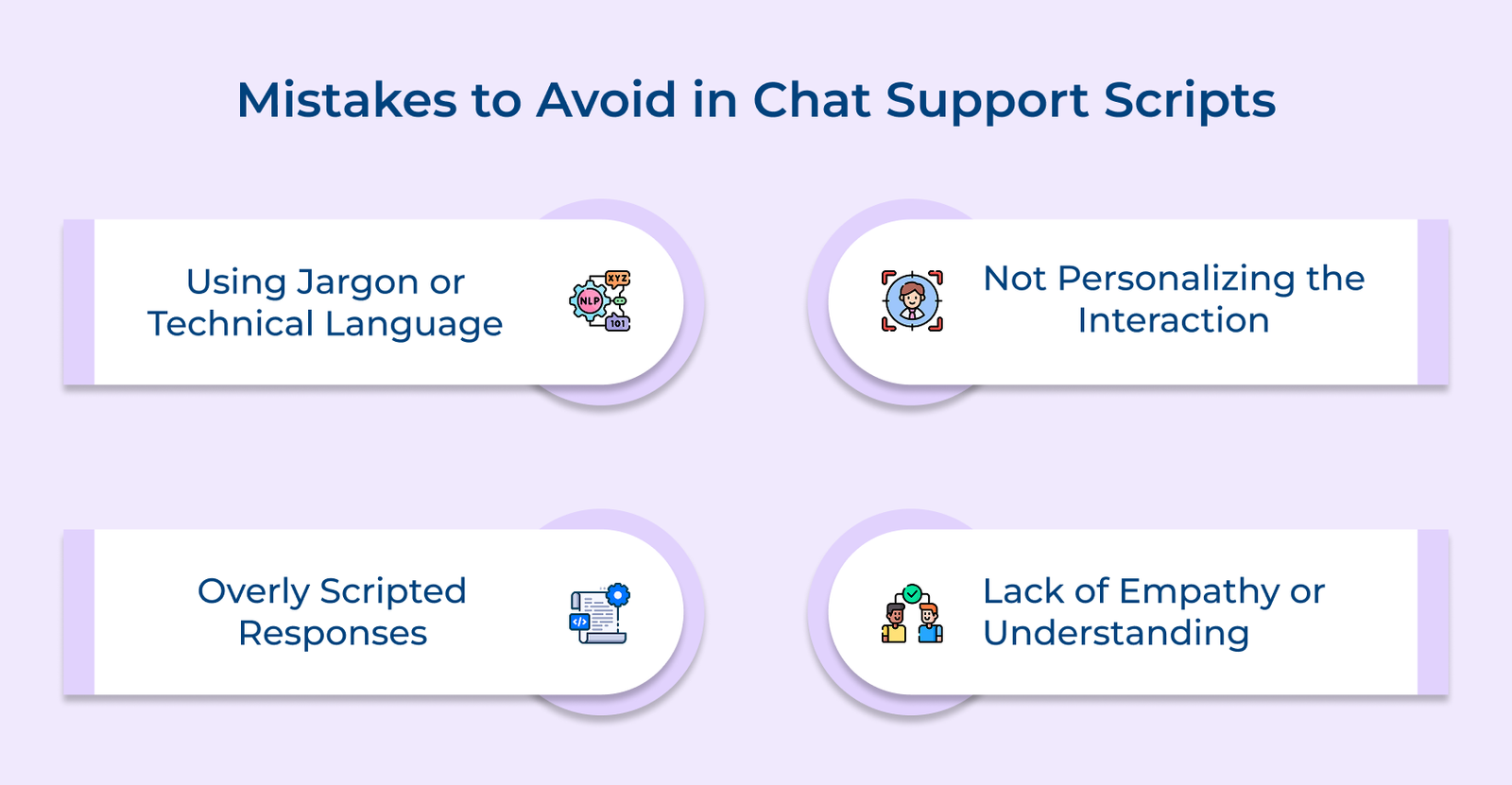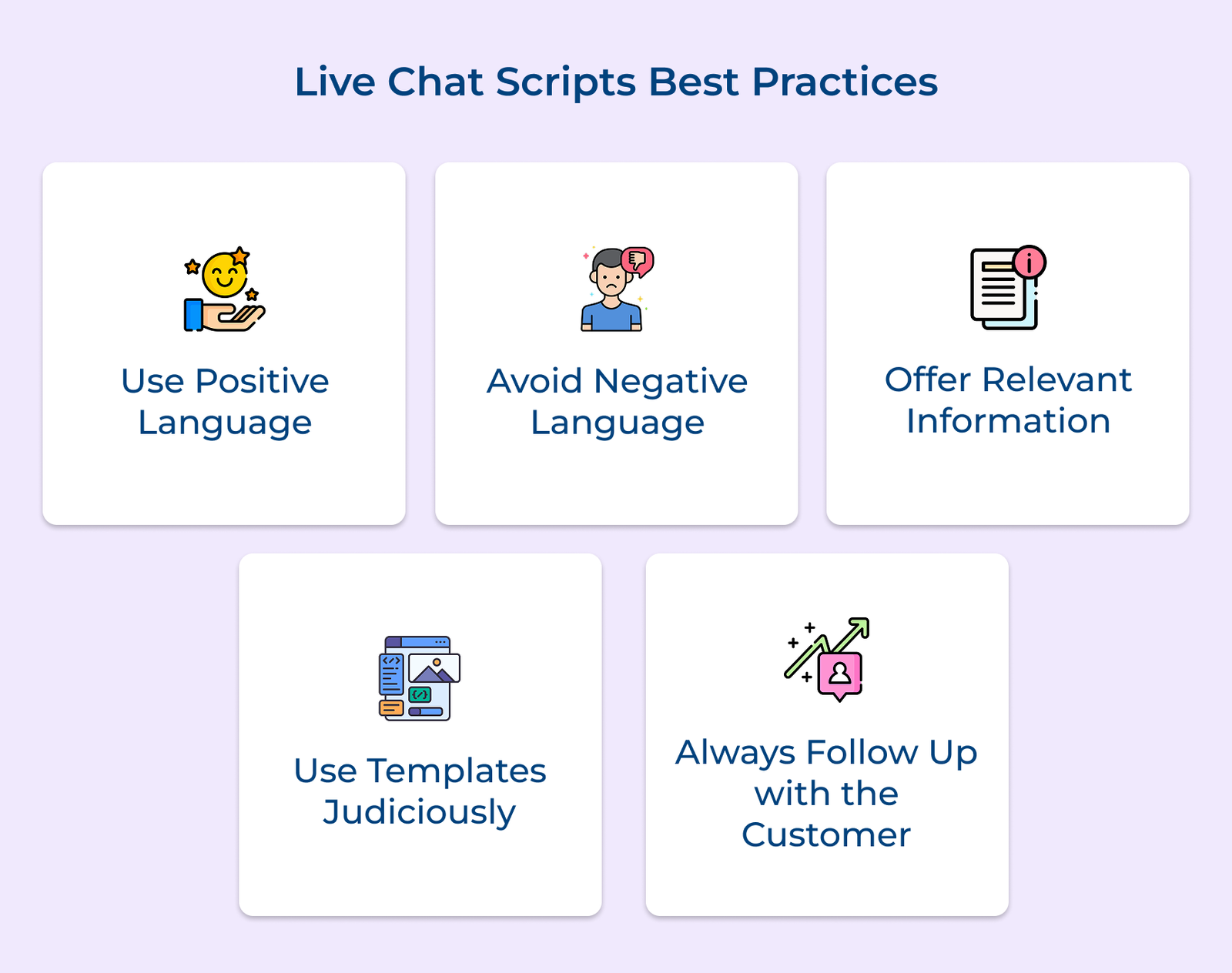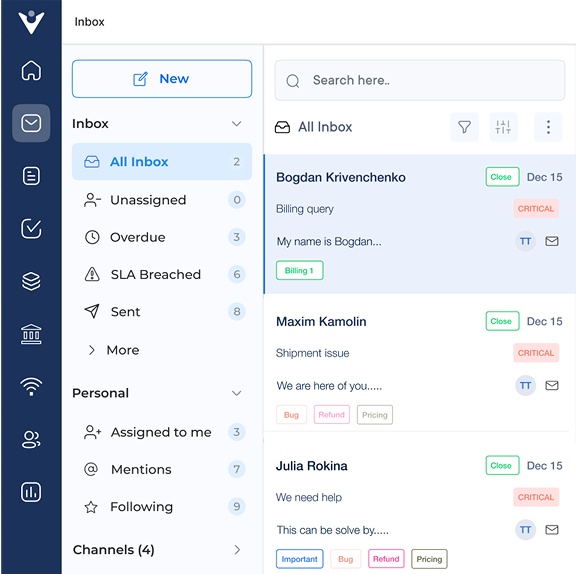1. Chat Support Scripts for General Greetings
Live chat support scripts for general greetings are an essential component of any customer service team’s toolkit. These types of chat scripts are designed to provide a warm and professional welcome to customers who initiate a chat session, setting the tone for a positive interaction.
The key benefit of using general greeting scripts is that they help standardize the customer service experience. It ensures that all customers receive a consistent level of service and improves customer satisfaction.
1. “Hello! Thank you for reaching out to us. How can I assist you today?”
2. “Hi there! Welcome to our live chat support. How can I help you?”
3. “Good [morning/afternoon/evening]! How can I assist you today?”
4. “Hello, [Company Name] support here. How may I assist you?”
5. “Greetings! Thank you for contacting us. How can I support you today?”
Best practices:
- Personalize the greeting by using the customer’s name, if known.
- Keep the greeting concise and professional.
- Always follow up the greeting with an offer of assistance to show the customer that the brand is ready to help.
2. Live Chat Scripts for Repeat Visitors
Live chat scripts for repeat visitors are essential tools for creating personalized and efficient customer interactions. They are tailored to engage with customers who have visited the website multiple times, providing a seamless and consistent experience.
One key advantage of using chat scripts for repeat visitors is the ability to build customer loyalty and trust. Recognizing repeat visitors allows businesses to show that they value their customers and are committed to providing excellent service.
6. Welcome back! We’re glad to see you again. Is there anything specific you’re looking for today?
7. Hi there! It’s great to have you back. Did you have any questions about our products or services?
8. Welcome, loyal customer! We appreciate your continued support. How can we assist you today?
9. Hello again! We’re here to help you with anything you need. Feel free to ask us anything.
10. It’s always a pleasure to have you back on our website. How can we make your online experience even better today?
Best practices:
- Personalize the script with the customer’s name or previous interactions to show that the brand values their continued business.
- Use data from past visits to offer relevant recommendations or promotions. Increasing the chances of repeat purchases.
3. Chat Scripts for Picking Up Where you Left Off
Using chat scripts to pick up where the brand left off helps to seamlessly continue a conversation with customers who may have had a previous interaction. Businesses can easily personalize their customer experience and build rapport by referencing past conversations or issues discussed.
Let’s look at an example of a customer reaching out with a question about a product they had inquired about a few days prior. Using a script to pick up where the brand left off, the customer service representative can easily reference the previous conversation. Acknowledge the customer’s interest and provide further assistance or information.
11. “Hello [Customer Name], I see that you had some questions about our new product last time we spoke. How can I assist you today?”
12. “Welcome back, [Customer Name]! I remember we discussed your current billing address issue last time. Have you had a chance to review the options we discussed?”
13. “Hi [Customer Name], it’s great to chat with you again. I recall you were interested in our services. How can I help you move forward with your decision?”
14. “Good to see you again, [Customer Name]. I believe we were working on resolving that technical issue. Are you still experiencing any difficulties?”
15. “Hey [Customer Name], I remember you were interested in our upcoming event. Have you had a chance to register?”
Key takeaways:
- Personalization: Personalize the script with specific details from previous interactions.
- Active listening: Be attentive to the customer’s needs and use the script to show that the brand is actively listening.
4. Scripts to Send when a Customer is on a Pricing Page
Live chat scripts for every type of customer interaction play a crucial role in guiding potential customers through the sales process. One key type of script to have on hand is for when a customer is on a pricing page. It helps answer any questions the customer may have about pricing, features, or any other concerns before making a purchase.
One important use case for such scripts is to address any pricing or feature-related questions that may be preventing the customer from making a purchase. Having a script ready to go allows customer service agents to quickly address these concerns and provide the information needed to help close the sale.
16. “I see you’re on our pricing page, how can I assist you with deciding on the best plan for your needs?”
17. “Are there any specific features you’re looking for in a plan that I can help you with?”
18. “Have you checked out our pricing options? I can walk you through each plan and help you decide on the best fit.”
19. “Did you have any questions about our pricing structure? I’m here to help answer any concerns you may have.”
20. “If you need help comparing plans or understanding our pricing, feel free to ask me for assistance.”
Pro tips:
- Discounts and offers: Be prepared with information on discounts, promotions or any special offers that may be available to the customer.
- Customer encouragement: Encourage the customer to take action by providing clear next steps or a call-to-action to move forward with the purchase.
5. Scripts For a Checkout Page
Scripts for a checkout page are pre-written responses that customer service representatives can use to guide customers through the checkout process. They often use it to answer any questions they may have and address any concerns or issues that may arise.
One important use case for checkout page scripts is when a customer encounters an error during the checkout process. Having a script ready to address common errors such as payment processing issues can help resolve the problem quickly.
21. Thank you for your purchase! Your order has been successfully submitted.
22. I’m sorry to hear you’re having trouble with your payment with a credit card. Let me help you troubleshoot.
23. Could you please provide your shipping address so we can ensure prompt delivery?
24. Would you like to add any additional products to your order before checkout?
25. Thank you for choosing us for your purchase. Is there anything else I can assist you with?
Best practices:
- Use the script as a guideline but be flexible and adapt to the customer’s specific needs.
- Continually review and update scripts based on customer feedback or common issues encountered.
6. Cross-selling and Upselling Scripts
One notable use case demonstrating the importance of cross-selling and upselling scripts is in the retail industry. Let’s take an example of a customer browsing online for a new laptop who may be offered a discounted printer as a cross-sell or as an upsell. These personalized suggestions can lead to a higher purchase value and a satisfied customer who feels well taken care of.
30. “Based on your purchase history, I recommend these complementary products.”
31. “Upgrade to our premium service for additional features and benefits.”
32. “Add the item to your cart to qualify for free shipping.”
33. “Customers who bought this item also purchased these related products.”
34. “Save money by bundling these items together as a package deal.”
Pro tips:
- Suggestions: Tailor suggestions based on the customer’s browsing history and purchase patterns.
- Focus on language: Use persuasive language to highlight the value and benefits of the additional products or services.
- Discounts: Offer exclusive discounts or promotions to incentivize customers to make a purchase.
7. Scripts For Promoting a Product
Live chat scripts are significantly important for promoting products and engaging with customers in real-time on websites, email addresses or social media platforms. These chat scripts help guide customer interactions, provide information and eventually lead to conversions.
26. Product information script: “Our product is known for its high quality and durability. Would you like more information on its features and benefits?”
27. Discount offer script: “We are offering a special discount on this product for a limited time. Would you like to take advantage of the opportunity?”
28. Customer testimonial script: “Many customers have raved about how this product has improved their lives. Would you like to hear some testimonials?”
29. Closing script: “Thank you for chatting with us today. If you have any further questions or would like to make a purchase, feel free to reach out to us at any time.”
Key takeaways:
- Personalize the script to match the customer’s needs and preferences.
- Keep the language clear, concise and persuasive to drive sales.
- Include open-ended questions to engage customers and encourage dialogue.
8. Scripts for Thanking the Customer for Waiting
Customers will inevitably have to wait at times, but they always appreciate being acknowledged and thanked for their patience whether it’s to speak to a representative or to get a response. That’s where scripts for thanking the customer for waiting come in handy.
35. “I appreciate your patience. Your time is valuable to us and I’ll do my best to resolve your issue quickly.”
36. “Thank you for waiting. I’m working on finding a solution for you as quickly as possible.”
37. “I apologize for the delay. Your patience is greatly appreciated and I’m here to help you now.”
38. “Thank you for your understanding. I’m grateful for your patience as I work to assist you.”
Best practices:
- Be sincere in showing empathy towards the customer.
- Offer a brief explanation for the delay if possible to provide context.
- Express a willingness to help and assure the customer that their wait was worth it.
9. Asking Customers For More Time
Asking customers for more time during live chat interactions is a crucial aspect of providing excellent customer service. Being able to gracefully ask for more time can make a significant difference in customer satisfaction whether it’s to address a complex issue or gather additional information.
One common use case where asking for more time is important is when a customer is struggling to articulate their issue. Politely requesting more time to assist them allows the brand to show that the brand is dedicated to helping them find a solution.
39. “I want to make sure I fully understand your situation. Can you please give me a moment to review your account details?”
40. “I appreciate your patience. Would you mind if I take a few extra minutes to research the best solution for you?”
41. “I want to provide you with the most accurate information. Can I have a brief moment to verify some details?”
42. “I value your time and want to make sure we address all of your concerns. Can I have a bit more time to assist you?”
Best practices:
- Clear communication: Communicate why the brand needs more time and assure them of the commitment to resolving their issue.
- Expectation: Set customer expectations for how long the delay may be and provide updates if the situation changes.
10. Apology Scripts for Not Meeting a Customer Request
Imagine a scenario where a customer reaches out to the company with a specific request, only to be told that it cannot be fulfilled. How the brand handles such a situation can greatly impact the customer’s perception of the brand. Using an apology script will help businesses show empathy toward the customer’s disappointment while also offering alternative solutions.
43. “I’m sorry that we couldn’t meet your request. Can I offer you a complimentary upgrade on your current product as a token of apology?”
44. “I understand your frustration and I apologize for the inconvenience. How about we schedule a call to discuss alternative solutions that may better suit your needs?”
45. “I apologize for any disappointment this may have caused. Let me escalate this issue to our team to see if there are any other options available for you.”
Pro tips:
- Always show empathy and understanding towards the customer’s disappointment.
- Offer alternative solutions or compensations to make up for the inconvenience.
- Follow up with the customer to ensure their satisfaction and maintain good relations.
11. Scripts for Transferring Chat Conversation
“Scripts for transferring chat conversation” are essential live chat script types for every customer interaction. They make the transitions smoother between customer service representatives, leading to efficient and effective customer service.
46. “Thank you for your patience. I will transfer you to our technical support team for further assistance.”
47. “I will escalate your concern to our billing department. Please hold for a moment.”
48. “Let me transfer you to our product specialist who can address your specific inquiry.”
49. “I recommend speaking with our customer retention team. I will transfer you now.”
50. “I will connect you with a supervisor to address your issue promptly.”
Best practices:
- Customer concern: Always confirm with the customer before transferring the chat to ensure they are comfortable with the transition.
- Introduction: Provide a summary of the conversation to the new representative to avoid repetition and enhance the customer experience.
- Follow up: Follow up with the customer after the transfer to ensure their concern was addressed satisfactorily, showing commitment to their satisfaction.
12. Ending the Chat Conversation Scripts
Having effective ending chat conversation scripts is important for businesses to leave a positive impression. These chat scripts help bring closure to the conversation and ensure that customers feel satisfied with the support they have received.
51. “I’m glad we were able to resolve your issue today. If you need any further assistance, don’t hesitate to reach out. Have a wonderful day!”
52. “Thank you for your patience throughout this conversation. If you have any more concerns, please don’t hesitate to let us know. Have a fantastic day!”
53. “I appreciate your understanding. If you have any more questions in the future, feel free to reach out to us. Have a lovely day!”
Best practices:
- Friendly tone: Use a friendly and professional tone to leave a positive impression.
- Assistant: Always offer further assistance or follow-up if needed to show the customer that their satisfaction is a priority.
13. Customer Satisfaction Survey Request
A live chat script for requesting customer satisfaction surveys should be friendly, concise and provide clear instructions on how to proceed. It is important to show appreciation for the customer’s time and feedback.
54. “Thank you for choosing our services! We value your feedback and would love to hear about your experience. Would you be willing to take a quick survey to help us improve?”
55. “We strive to provide the best customer service possible. Your feedback is invaluable to us. Can we send you a short survey to gather your thoughts?”
56. “Your opinion matters to us! Please take a moment to share your feedback with us through a brief survey. Your input will help us enhance our services.”
57. “We want to ensure your experience with us was positive. Help us by sharing your feedback through a quick survey. We appreciate your time!”
Key takeaways:
- Provide a clear call to action: Make it easy for the customer to participate in the survey.
- Follow up: Send a thank you message after the survey is completed to show appreciation for the customer’s feedback.
Common Mistakes to Avoid in Chat Support Scripts
Below are some common mistakes to avoid in chat support scripts to ensure your team delivers clear, helpful and engaging responses to build lasting relationships.





